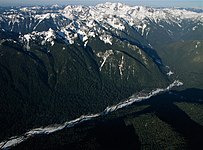Woden - The Valhallas
History
These peaks were originally named "Pleiades Peaks" by Robert L. Wood, a reference to the seven daughters of Atlas in Greek mythology, however this name did not stick. Glenn Kelsey and Harold Pinsch climbed in this area in 1970 and are credited with the Valhallas name. In Norse mythology, "Valhalla" is a great hall located in Asgard, ruled over by the god Odin, who in Old English was known as "Woden". The peak, Woden, may have originally been named "Mount O'Neil" by the 1890 Seattle Press Expedition in honor of Lt. Joseph O'Neil, who led an earlier 1885 exploration into the Olympic wilderness. The first ascent of Woden was made in 1966 by Ernie Labistida and Ivan Lindgren.
Climate
Based on the Köppen climate classification, The Valhallas are located in the marine west coast climate zone of western North America. Weather fronts originating in the Pacific Ocean travel northeast toward the Olympic Mountains. As fronts approach, they are forced upward by the peaks (orographic lift), causing them to drop their moisture in the form of rain or snow. As a result, the Olympics experience high precipitation, especially during the winter months in the form of snowfall. Because of maritime influence, snow tends to be wet and heavy, resulting in avalanche danger. During winter months weather is usually cloudy, but due to high pressure systems over the Pacific Ocean that intensify during summer months, there is often little or no cloud cover during the summer. The months July through September offer the most favorable weather for viewing or climbing these peaks.
Geology
The Olympic Mountains are composed of obducted clastic wedge material and oceanic crust, primarily Eocene sandstone, turbidite, and basaltic oceanic crust. The mountains were sculpted during the Pleistocene era by erosion and glaciers advancing and retreating multiple times.
Summits
Select named peaks of The Valhalla Range All are named after Norse gods, except Sleipner (Odin's horse) and Pelton.
| Name | Elevation (feet) | Prominence (feet) | First ascent | Reference |
|---|---|---|---|---|
| Woden | 6,038 | 1,038 | 1966 | |
| Hugin | 6,000+ | 80 | 1966 | |
| Munin | 6,000+ | 160 | 1971 | |
| Thor | 5,968 | 328 | 1971 | |
| Loki | 5,920+ | 1971 | ||
| Baldur | 5,720+ | 160 | 1971 | |
| Mimir | 5,480+ | 40 | 1978 | |
| Vili | 5,487 | 87 | 1978 | |
| Frigga | 5,406 | 246 | 1971 | |
| Bragi | 5,400+ | 40 | 1978 | |
| Vidar | 5,637 | 677 | 1978 | |
| Mount Sleipner | 5,520 | 520 | 1978 | |
| Pelton Peak | 5,301 | 541 |
Gallery
-
The Valhallas with Geri-Freki Glacier
-
Front to back: Queets River, The Valhallas, Mt. Olympus
-
Baldur centered, Frigga to right.
-
Woden centered, Hugin immediately left, Munin upper right
-
The Valhallas from the southeast
See also
References
- ^ "The Valhallas-Woden". Peakbagger.com.
- ^ ""Woden" - 6,038' WA". listsofjohn.com. Retrieved August 26, 2020.
- ^ Woden climbersguideolympics.com
- ^ Parratt, Smitty (1984). Gods and Goblins: A Field Guide to Place Names of Olympic National Park (1st ed.).
- ^ Peel, M. C.; Finlayson, B. L.; McMahon, T. A. (2007). "Updated world map of the Köppen−Geiger climate classification". Hydrol. Earth Syst. Sci. 11: 1633–1644. ISSN 1027-5606.
- ^ McNulty, Tim (2009). Olympic National Park: A Natural History. Seattle, Washington: University of Washington Press.
- ^ Alt, D.D.; Hyndman, D.W. (1984). Roadside Geology of Washington. pp. 249–259. ISBN 0-87842-160-2.
- ^ Valhalla Range, climbersguideolympics.com
- ^ "Hugin, Washington". Peakbagger.com.
- ^ "The Valhallas-Munin, Washington". Peakbagger.com.
- ^ "The Valhallas-Thor, Washington". Peakbagger.com.
- ^ "Loki, Washington". Peakbagger.com.
- ^ "Baldur, Washington". Peakbagger.com.
- ^ "Mimir, Washington". Peakbagger.com.
- ^ "Vili, Washington". Peakbagger.com.
- ^ "Frigga, Washington". Peakbagger.com.
- ^ "Bragi, Washington". Peakbagger.com.
- ^ "Vidar North, Washington". Peakbagger.com.
- ^ "Sleipner, Washington". Peakbagger.com.
- ^ "Pelton Peak, Washington". Peakbagger.com.
External links
- "Olympic National Park". National Park Service.
- Weather forecast: National Weather Service




